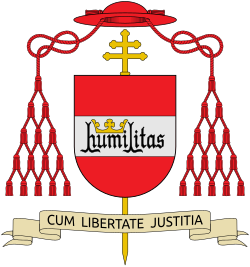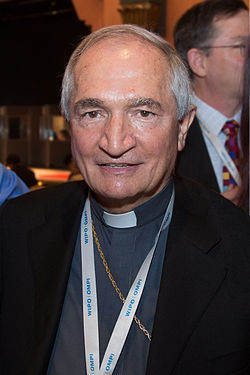Geneva role
On 10 June 2003, Tomasi was appointed Permanent Observer of the Holy See to the United Nations in Geneva. [10]
He was widely criticised in September 2009 following a speech in which he praised the Catholic Church's record on child sex abuse in comparison with that of other organisations by arguing that "Of all priests involved in the abuses, 80 to 90 percent belong to this sexual orientation minority which is sexually engaged with adolescent boys between the ages of 11 and 17". He also claimed that "As the Catholic church has been busy cleaning its own house, it would be good if other institutions and authorities, where the major part of abuses are reported, could do the same and inform the media about it." [11] [12]
Tomasi "encouraged passage of an international protocol that would give children a direct line of communication to local and international authorities when they are victims of violence or their rights are violated", saying that the measure "will become a significant instrument of the human rights system." The document would add to the protections provided in the United Nations Convention on the Rights of the Child. Speaking on 8 June 2011 at the U.N. International Labor Conference in Geneva, Archbishop Tomasi urged that all involved in "the burgeoning and mercurial economic system" work to foster fundamental principles that ensure respect for the common good and protection of the most vulnerable. [13]
In 2014 the U.N. Committee on the Rights of the Child issued a report [14] described as "a scathing indictment of the Vatican’s handling of child sexual abuse cases involving clerics, releasing a report that included criticism of church teachings on homosexuality, gender equality and abortion" [15] which was seen as an indictment of the Catholic Church's handling of child sexual abuse cases involving clerics, going beyond how the church managed abuse allegations to include criticism of its teachings on homosexuality, gender equality and abortion. Archbishop Tomasi appeared before a UN committee in Geneva. Vatican officials said they were still studying the findings, but responded angrily to what they claimed were ideologically biased recommendations. Fr Thomas Rosica claimed that the UN report wrongly singled out Catholicism. [15] Tomasi said that he suspected pro-gay rights NGOs had influenced the committee and "reinforced an ideological line" in the UN. [16]
Tomasi has been critical of autonomous weapons systems, stating that they can never comply with international human rights law and will make warfare less humane. [17]
In 2014, he commented that American military action in Iraq may be necessary. [18] [19] He considered there to be a moral imperative for the action, and that the UN Charter justified the use of force in this circumstance. [20]
In 2015 Tomasi said jihadists were committing "genocide" and must be stopped, preferably without violence but using force if necessary. [21] [22]
Tomasi retired from the diplomatic service upon the announcement of the appointment of his successor in Geneva on 13 February 2016. [23] He retains the title "Apostolic Nuncio". [1] In the second half of 2016, he managed the reorganization of several offices of the Roman Curia to form the new Dicastery for Promoting Integral Human Development. [24]


